The World's Most Stolen Painting
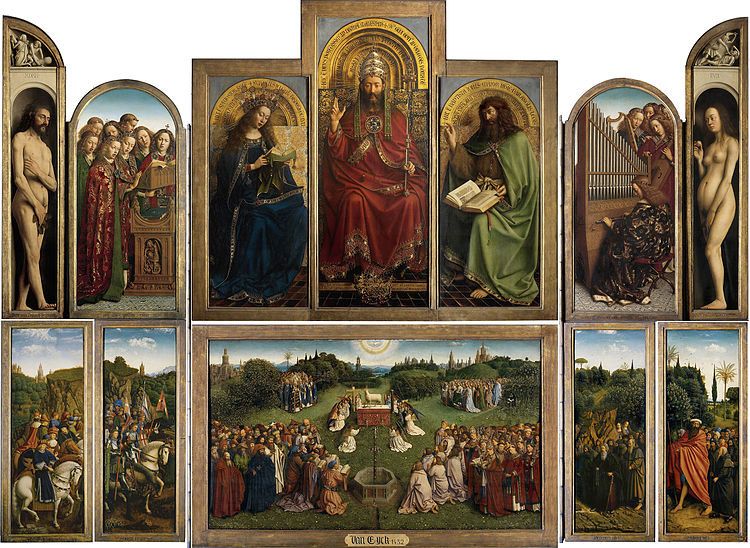
The Ghent Altarpiece (or the Adoration of the Mystic Lamb) is a large and complex 15th-century polyptych altarpiece begun in the mid-1420s and completed by 1432. It is attributed to the Early Flemish painters and brothers Hubert and Jan van Eyck.1
Art historians generally agree that the overall structure was designed by Hubert during or before the mid-1420s, probably before 1422, and that the panels were painted by his younger brother Jan. Yet, while generations of art historians have attempted to attribute specific passage to either brother, no convincing separation has been established, it may be that Jan finished panels begun by Hubert.1
The altarpiece is considered a masterpiece of European art and one of the world's treasures.1 But it has had a somewhat tumultuous life and as a result it now lives inside a £26million glass case home inside St Bavo's Cathedral, Ghent, Belgium. 2
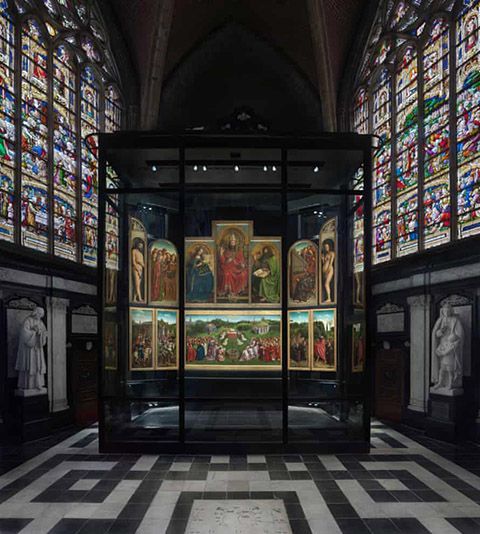
It's not the purpose of this post to describe and analyse the art work but rather to give you an account of the crimes that have befallen this famous piece. If you would like to know more about the actual work please follow this link to read a detailed account of the Ghent Altarpiece.
The altarpiece seems to have been doomed from the start to a precarious life as the predella (the long horizontal structure at the base or 'foot' of an altarpiece) was damaged sometime in its early life as a result of some shonky restoration work. 1 However the first real threat came from the Iconoclastic Fury (Beeldenstorm in Dutch, Bildersturm in German) which accompanied the Protestant Reformation taking place in Europe in the C16th. 1
To protect it from the Protestants, the altarpiece was moved, first to the attic (I think in the precincts of the Cathedral) and then to the Ghent town hall where it stayed for many years. Guards were later employed to protect it from the rioting Calvanists.
But luck ran out in 1794 with the arrival of the French Revolution and Napoleon Bonaparte who coveted the piece and was intent on using it to enlarge the Louvre in Paris which had just been set up as a museum in 1793. Below is a print made of Napoleon parading through the galleries of the Louvre.
Napoleon's troops managed to steal four panels of the altarpiece for display in Paris.3 It was returned to Ghent in 1815 after the French were defeated at the Battle of Waterloo. 1

The tumult was not over for the altarpice. A year after the return of the four stolen panels from Paris, six of the wing panels were hastily sold off by one of the canons of St Bavo’s Cathedral, who deemed them old and worm-eaten. The altarpiece was now essentially split in two. The sold panels eventually ended up in the possession of the King of Prussia, and went on show in Berlin.3
Meanwhile, back in Ghent, the remaining panels had their own tribulations to contend with. In 1822, a fire broke out in the roof of St Bavo’s Cathedral and the four panels that lived there had to be rescued. Though damaged, they were not beyond repair, and two rounds of restoration during the 19th century redeemed their condition. 3
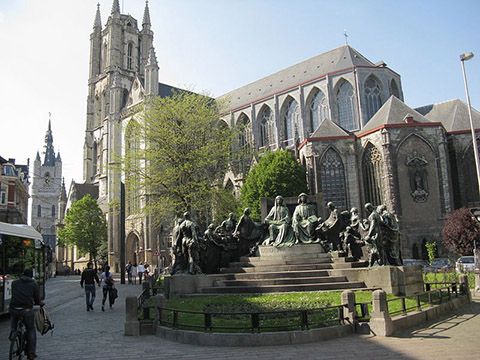
The Berlin panels stayed in Germany for nearly one hundred years, at one point being sawed through to enable the double-sided panels to be better displayed together. They were eventually returned to Ghent after the First World War, when the Treaty of Versailles made the restoration one if its conditions.3
At this point I become a little confused because I have read that German troops during WWI took panels from the altarpiece and they were returned as a result of the Treaty of Versailles.
Whatever the facts are, finally, the Ghent Altarpiece was united again in 1932, and a ceremony was held to mark the quincentenary of the work.3
The Altarpiece enjoyed two years of safe and secure peace until the night of 10 April 1934 when ... thieves broke into the cathedral and stole the lower-left panels featuring the Just Judges and St John the Baptist. The perpetrators proceeded to slice the panel vertically in half; the back side, containing a painting of Saint John the Baptist, was left — perhaps on purpose — in Ghent train station. The thieves then sent a ransom letter demanding one million Belgian francs (about $25,000) in exchange for the return of the other side of the panel. The payment was never made and the panel remains lost to this day.3
A replica was commissioned and painted by Jef van der Veken in 1939 and is shown below. What makes the story even more intriguing is that van der Veken was not only a brilliant restorer but also just happened to be a well known art forger!! There are some who believe that the van der Veken replaced panel is in fact the original, painted over and surreptitiously returned after ransom negotiations failed. 5
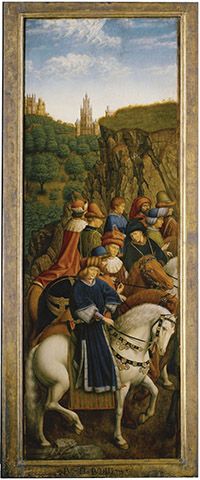
Such a famous piece of art work was destined to come to the attention of the Nazis during and apparently both Adolf Hitler and Hermann Göring desired the artwork, in part perhaps because they saw its acquisition as a corrective to the Treaty of Versailles. When, in 1940, the German army entered Belgium, Hitler’s forces located the altarpiece — which at the time was en route to the Vatican for safekeeping.3
In 1940... a decision was made in Belgium to send the altarpiece to the Vatican to keep it safe during World War II. The painting was en route to the Vatican, but still in France, when Italy declared war as an Axis power alongside Germany. The painting was stored in a museum in Pau for the duration of the war, with French, Belgian and German military representatives signing an agreement which required the consent of all three before the masterpiece could be moved. In 1942, Adolf Hitler ordered the painting to be seized and brought to Germany to be stored in the Schloss Neuschwanstein in Bavaria. The seizure, led by senior museum administrator Ernst Buchner and aided by officials in France, was ostensibly to protect the altarpiece from war. After Allied air raids made the castle too dangerous for the painting, it was stored in the Altaussee salt mines, which greatly damaged the paint and varnish. Belgian and French authorities protested the seizing of the painting, and the head of the German army's Art Protection Unit was dismissed after he disagreed with the seizure. 1
Following the war, in 1945, the altarpiece was recovered by the Allied group Monuments, Fine Arts, and Archives program and returned to Belgium in a ceremony presided over by Belgian royalty at the Royal Palace of Brussels, where the 17 panels were displayed for the press. French officials were not invited as the Vichy government had allowed the Germans to remove the painting. 1
Since being returned to the Ghent Cathedral the altarpiece has undergone several major restorations.
It is an amazing story and a miracle that it has survived at all. Below is an image showing you some of the detail and I am sure you can see why it is considered to be such a rare example of C15th art.
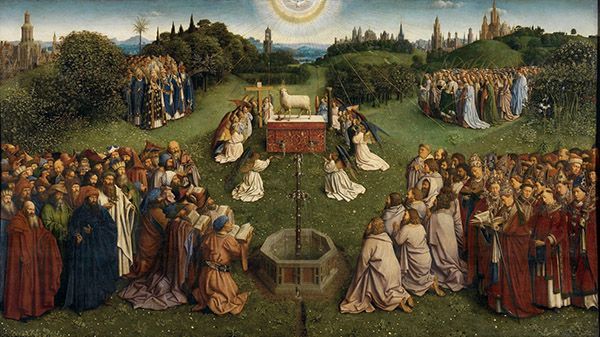
Credits
1. en.wikipedia.org
2. theguardian.com
3. medium.com
4. wellcomecollection.org
5. theartnewspaper.com

